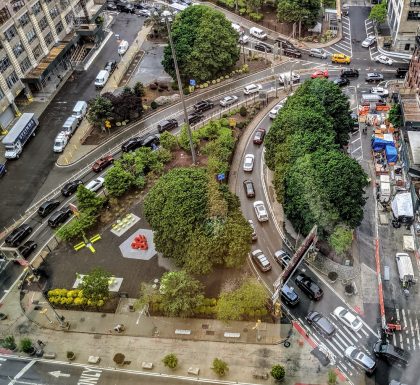Are we facing a new wave of car traffic?
Anyone who has driven north or east on a late afternoon recently knows that traffic, sadly, is back. But with the neighborhood half empty and only a fraction of workers at their desks across the city, it’s been a bit of a surprise — and maybe a signal of some unpleasant things to come. Add that to the very quiet subways and it’s clear that car traffic is more robust than usual. That’s something that the city has to start paying attention to — and certainly we should as downtowners — as each phase brings more workers into town.
A couple of studies have already shown that even after the pause ends, riders say will not be heading back to mass transit. The MTA predicts that only 60 percent will come back, and some studies say it could be as high as 50 percent. Right now subway ridership is down by 84 percent, with 800,000+ riders a day vs. the usual 8 million (bus ridership is down around 58 percent).
In an opinion piece in the Wall Street Journal last month, the president of the New York Stock Exchange, Stacey Cunningham, announced that when the exchange opened (which it did on May 26), it would have a limited number of floor traders and employees coming back to the office, with most staying at home. But here’s where neighbors come in: she added that the NYSE will “require all comers to avoid public transportation, which will limit their exposure and preserve capacity for others.” The communications office clarified that this policy is only in place until the NY on PAUSE order is lifted — but at what phase he didn’t say. The NYSE is only a few hundred employees, but if others follow this policy, it’s a big pileon.
As outlined in today’s WSJ opinion piece, NYSE will require trading floor personnel to avoid public transportation to reserve social distancing capacity for frontline workers and limit daily community interactions, while Gov. Cuomo’s NY on PAUSE order is in effect.
— NYSE ???? (@NYSE) May 16, 2020
Some downtown firms could get smart about this. I’ve heard through the grapevine that a couple financial firms are considering “Google shuttles” — the swank buses that Google uses to bring a good chunk of its workforce from San Fran to its campus in Mountain View — to bring its employees downtown from the Upper West Side and other neighborhoods, so workers can avoid the subway. In California, the service saves thousands of car trips a day.
Maybe the lack of parking will cap the number of cars, but that has never stopped them in the past. There’s no way this has a happy ending for downtown unless we get a grip on it soon.















Keep the traffic coming… unless we’re keen on watching the rest of the few remaining shops and restaurants get decimated. Whatever it is at now is still far less vehicle traffic than normal, and the big garages in the area are still largely empty. Maybe when traffic for the Holland is backed up every day to Reade St, some of those folks might even want to get a place down here to ditch the commute.
Would be nice.
It’s interesting that bus ridership is not down as much. Maybe one solution is to add more bus routes and lanes…
Some steps in this direction:
http://secondavenuesagas.com/2020/06/09/thoughts-as-the-mayor-unveils-just-20-miles-of-new-busways-and-bus-lanes-as-nycs-pandemic-response/
Unlike the subways, buses have been effectively fare-free since they blocked off the front entrance during the pandemic. They have run 24 hours and as a substitute for essential workers during the late night subway shutdown and with fewer homeless people overrunning them.
Whose first choice in a respiratory disease pandemic is to ride in a hole in the ground?
IMO MTA should first compare ridership in those areas served by both means of transit. Plenty of outer-borough resident essential workers live where no subways exist to bring them to Manhattan. I would bet plenty of office-working and other commuters who typically ride the subway to/from Grand Central and Penn Station and PATH as their last travel leg have been staying-at-home and not riding the City bus instead.
Thank you for the reminder about the fare-free buses. I’ve only taken a couple of bus rides in this shutdown and indeed they were fare-free; there was actually no way to pay since the driver area with the MetroCard reader was roped off. Surely MTA can’t keep operating fare-free though as the city re-opens, unless the bail-out money is unlimited.
True that going underground seems more dangerous in pandemic times, both since enclosed unventilated spaces are higher infection risk, and apparently there has been more subway crime.
A thought: perhaps buses need to have openable windows again. Since buses are still enclosed spaces and thus higher infection risks.
One of the reasons I prefer NYC to other cities is that you don’t need a car to survive here. Maybe I’ll find myself walking long distances a lot more often.
I’ve been commuting via the 1, 2, 3 to 34th or 42nd the last two weeks and have found the trains very clean but eerily empty. Being exposed to germs is not an issue at all because so far whether I travelled at 9am or 11am, you’re hard pressed to find a train w/at least 2 ppl in it. By late afternoon, you’ll get approx. 4-6 ppl/car heading downtown which, for me, feels way more safe especially for a woman. My co-workers from the UWS have the opposite issue, they complain of more crowded trains (12-16 ppl) with a few ppl not wearing masks. I’m hoping phase 2 will bring more ppl into the trains and into midtown bc if it doesn’t happen soon, it’s going to decimate midtown and the surrounding areas :(